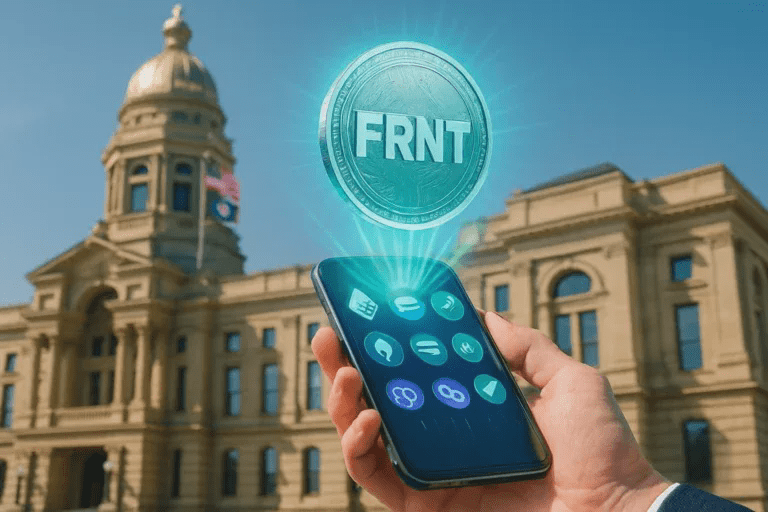In the landscape of digital finance in the United States, a multi-level struggle about the future is intensely unfolding. At the state level, Wyoming, with its consistent pioneering spirit, has recently officially launched the nation's first state-supported stablecoin, showcasing the immense potential of technological innovation to the world. However, at the federal level, an intense lobbying battle led by traditional banking giants aimed at shaping and even controlling the future of the digital dollar has also reached a fever pitch. These two distinctly different dynamics together reveal the complexity and profound contradictions that the United States faces in its transition to the era of digital currency.
State-Level Stablecoin

For a long time, Wyoming has been a legislative pioneer in the field of digital assets in the United States. Now, it has once again solidified this position through tangible actions by officially launching a stablecoin named 'FRNT'. This is not only a first in U.S. history, but its design concept and technical implementation also set a new benchmark for future government-level digital currencies.
The core advantage of FRNT lies in its unparalleled transparency and security. Unlike many stablecoins issued by private companies, each token of FRNT is fully backed 1:1 by U.S. Treasury bonds held in a trust managed in Wyoming. This means its value foundation is extremely solid and completely transparent, aimed at maximizing the elimination of users' concerns about the safety of reserve assets.
More forward-looking is its cross-chain deployment strategy. To achieve the widest applicability and interoperability, FRNT was launched simultaneously on seven major blockchain networks, including Ethereum, Polygon, Avalanche, Arbitrum, BNB Chain, Polkadot, and Osmosis. This initiative ensures that users and developers from different ecosystems can seamlessly access and use FRNT, greatly expanding its potential application scenarios, from personal payments to complex decentralized finance (DeFi) applications.
Through the issuance of FRNT, Wyoming is not only creating a new digital asset but also exporting a regulatory concept—namely, that through government-level credit endorsement and the highest standards of technical practice, a digital dollar solution can be created that embraces innovation while fully protecting user rights.
(GENIUS Act)
However, while Wyoming is actively innovating, a 'power struggle' concerning the future of stablecoins nationwide is fiercely unfolding in Washington. At the core of this struggle is the federal-level stablecoin regulatory legislative proposal known as the (GENIUS Act). In this battle, the banking sector, representing the traditional financial power of the United States, is exhibiting a posture that is not simply 'collaborative' or 'embracing', but rather a strongly exclusive 'resistance'.
Powerful banking lobby groups, represented by the American Bankers Association (ABA) and the Bank Policy Institute (BPI), are doing their utmost to influence the (GENIUS Act). Their core demand is not to stifle all stablecoins; on the contrary, they wish to control the future of stablecoins. In their submissions to legislators, they strongly oppose provisions in the bill that allow non-bank entities (such as fintech companies and cryptocurrency firms) to issue stablecoins.
The banking industry's argument is that stablecoins, as a payment tool highly similar to currency, should only be issued by federally insured deposit institutions (i.e., banks) that are subject to comprehensive, prudent regulation. They believe that allowing non-bank entities like tech companies to issue 'currency-like' instruments on a large scale without bearing the same level of capital requirements, liquidity management, and consumer protection responsibilities as banks would pose a significant threat to the stability of the entire financial system.
Therefore, the U.S. banking sector is not resisting the concept of 'stablecoins' itself, but is firmly opposing a future that is not led by them and allows technology companies to share 'minting rights'. Their goal is to modify the (GENIUS Act) to tightly bind the qualifications for issuing stablecoins with bank licenses, effectively excluding all potential competitors from the market.
Two Fronts
In summary, the future of stablecoins in the United States is unfolding along two distinctly different paths. At the state level, innovative forces represented by Wyoming are actively exploring best practices for government-supported digital currencies through tangible actions. Meanwhile, at the federal level, a power struggle over top-level design and market access qualifications is intensifying, with traditional banking leveraging all its political energy to tightly control the future digital dollar within its system.
Wyoming's FRNT stablecoin may represent one of the most ideal forms of stablecoins: issued by trusted entities, with transparent reserves and advanced technology. The banking industry's lobbying war reveals the ancient struggle over power, interests, and control that can never be avoided behind financial innovation. The final intertwining and outcomes of these two fronts will not only determine the ultimate form of the U.S. stablecoin market but also have far-reaching impacts on the future landscape of global digital finance.

